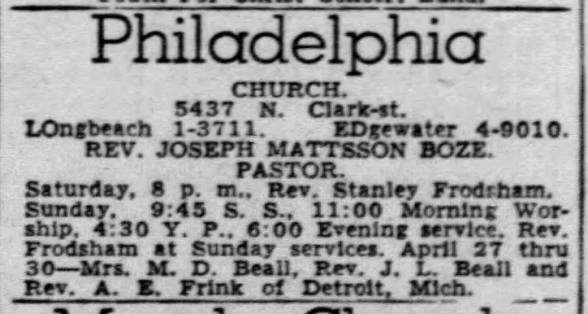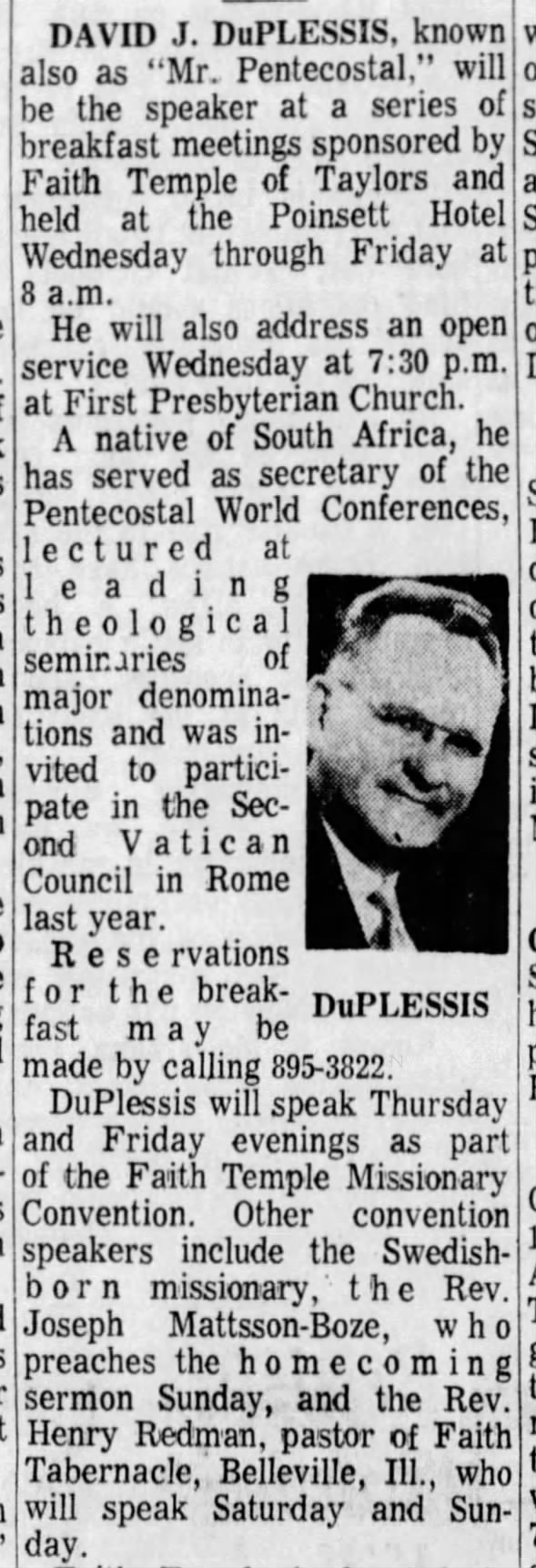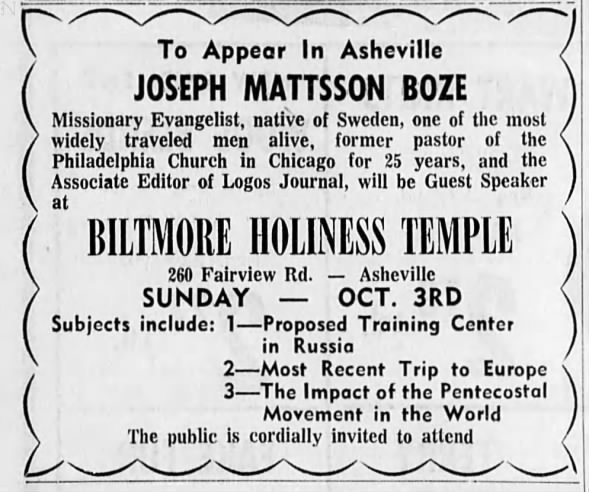 |
| The church Mattsson-Boze pastored in Chicago, Illinois (photo courtesy of Winston Mattsson-Boze) |
In a ministry that lasted more than five decades, Joseph Mattsson-Boze involved himself in true revivals wherever he found them.
Whether as a pastor, a missionary, or the editor of a magazine, Mattsson-Boze followed and publicized the moving of the Holy Spirit.
 |
| Joseph Mattsson-Boze |
And in October 1948, he got involved with the subject of this website, The Latter Rain Movement of 1948.
That revival got its start in North Battleford, Saskatchewan in February of 1948, and the ministers who led the work there (George Hawtin and others) were invited to speak at a convention October 24-31 in Edmonton by Pastor A. W. Rasmussen.
William Faupel, one of the historians who has written about the Latter Rain Movement, says, "One of the persons present, J. Mattson Boze [sic], an Independent Assemblies of God pastor and editor of The Herald of Faith, returned to his church in Chicago, Illinois, transformed. His church would become a strategic center for the Movement and his magazine a leading voice for the revival activity" (in Faupel's Ph. D. dissertation, The Everlasting Gospel: The Significance of Eschatology in the Development of Pentecostal Thought, University of Birmingham, UK, 1989).
The transformative power of the Edmonton meetings was testified to by Ern Baxter, no stranger to the power of the Holy Spirit, having traveled for several years with the healing evangelist, William Branham. In recounting some of the highlights of his ministry, Baxter said,
Another momentous thing happened - at least for me and many others - and that's something called the Latter Rain.... I went to their second convention in Edmonton, Canada and I never saw such a concentration of the power of God. This was a tremendous movement (in recording number EB001, "An Autobio and Intro," on the website, brokenbreadteaching.org).Richard Riss, whose book, The Latter Rain Movement of 1948 and the Mid-Twentieth Century Evangelical Awakening, is the most complete account to date of the revival, quotes James A. Watt, one of the North Battleford leaders, "Special healings were wrought: deaf heard, blind saw, cancers were healed, and sick bodies made whole. Sinners were saved, and the precious blood of Jesus availed in it all" (in Riss' paper, Singing in the Spirit in the Holiness, Pentecostal, Latter Rain, and Charismatic Movements, 1995).
Watt also reported that the Edmonton meetings were the first time that the phenomenon of the 'heavenly choir' was experienced in the Latter Rain revival. Primarily, the term refers to the harmonious sound created by the gathered worshippers' individually spontaneous songs of worship. Yet, as folks like Watt assert, there is also a supernatural aspect to the phenomenon. He says of the worship experience in Edmonton, "Heaven's very strains filled the whole church. It was as a mighty organ, with great swelling chords, and solo parts weaving in and out, yet with perfect harmony" (in Riss, Singing in the Spirit).
We would like to think that such outpourings and experience of the Holy Spirit would bring tranquility to the Body of Christ, but that is often not the case. Usually, many are being blessed and refreshed, while some are rankled at things that seem new and unfamiliar to them. Such was certainly the case in the Latter Rain revival.
Joseph Mattsson-Boze navigated safely through the choppy waters of blessed Latter Rain co-revivalists on one hand, and suspicious Pentecostal leaders on the other - all the while having to be careful of the occasional Latter Rain adherent who came up with heretical doctrines or fell into immorality.
 |
| Winston and his wife Ingrid |
"The lists of things they accuse latter rain-ers of seems silly. I grew up in the revival and didn't see those things. I'm sure they existed, but my father stood against them. He had the wisdom to not throw out the baby with the bathwater" (in, "Latter Rain," May 13, 2005).
Just over one year into the revival, some Pentecostals began to break fellowship with others due to concerns real and imagined. On April 20, 1949, the Assemblies of God sent out a six-page "special edition of the Quarterly Letter" for its ministers, warning them of what the AG called, the New Order of the Latter Rain:
By the end of 1949, ministers like Myrtle Beall, Vera Bachle, and Paul and Lura Grubb would be dropped from the AG General Council ministerial list. Stanley Frodsham, the editor of the AG's Pentecostal Evangel, was allowed to resign (but the resignation became necessary because of his Latter Rain involvement). In 1950, Mattsson-Boze wrote a letter to J. R. Flower, general secretary of the AG, defending the ministerial integrity of Winston Nunes, but to no avail, as Nunes would also be censured.For a long time little attention was paid to the reports reaching the headquarters office in Springfield, until finally it was learned that Mrs. [Myrtle] Beall, pastor of Bethesda Tabernacle [sic] in Detroit, Mich., had gone to Vancouver, B. C. and had been prayed with and hands were laid upon her. It is reported that she claims to have received the ministry of laying on of hands and is now exercising this ministry in company with others who are designated as prophets. We hesitate to refer to names and places, but this new order is being propagated from Detroit over four radio stations and on a daily schedule and therefore is being well publicized (in a letter dated April 20, 1949 from the executive office of the General Council of the Assemblies of God).
Then in 1956, although Mattsson-Boze was not a member of the Assemblies of God, an AG ministerial letter included a prohibition concerning ministering in his church. The December 5 letter read, "the Philadelphia Church is a non-co-operative [sic] church and ... its teachings and practices are completely out of harmony with the churches of the Assemblies of God."
 |
| David du Plessis |
Also, Joseph was chosen to serve alongside David du Plessis and the others on the executive committee of the 1949 Pentecostal World Conference in Paris.
As friends, Joseph and David shared many things, including a birthday - February 7, 1905; and when Fuller Seminary created the David du Plessis archive, du Plessis "requested that Mattson-Boze's letters be housed with his," according the David Allan Hubbard Library website.
The website tells how Mattsson-Boze also served on the executive committee for the first Pentecostal World Conference (Zurich, 1947) and, "One highlight of the conference for Mattsson-Boze was the agreement he authored with David du Plessis that allowed 'independents,' including Lewi Pethrus and the Swedish churches, to cooperate with the Pentecostal movement."
FRIENDSHIP WITH WILLIAM BRANHAM
Another friendship led down another avenue of revival - his friendship with William Branham from the Healing Revival that swept America in the 1940s and 1950s. Like Joseph's Latter Rain friends, Branham was a controversial figure.
 |
| Branham and Joseph |
Proof that Branham's relationship with the Latter Rain revival was tangential is found in a sermon he preached at Joseph's Chicago church called, Philadelphia Church.
In the December 13, 1953 sermon, Branham relates how he had been threatened with the cancellation of a speaking engagement by Voice of Healing ministers if he preached at Mattsson-Boze's church (not something you would do if someone was the leader of a movement; e.g., who would threaten the general superintendent of the Assemblies of God against preaching in an AG church?!) Branham responded:
"And here's what I want everyone to know from my heart: if you ministers are sitting here ... if you're Assemblies of God, if you're Oneness, if you're Baptist, Methodist ... or if you're first rain, second rain, fourth rain, Latter Rains, how many rains ... I don't care who you are. I don't care what church you represent. I'll go anywhere God leads me to go" (in the sermon, "Exploits of Faith" on williambranham.com).
Joseph reciprocated the loyalty shown by Branham. David Edwin Harrell Jr. notes, "During the 1950s the magazine most loyal to the work of William Branham was the Herald of Faith (1933 - 1970) published in Chicago by Joseph Mattsson-Boze" (in All Things are Possible: The Healing and Charismatic Revivals in Modern America).
The website for the Hubbard library adds, "The Mattsson-Boze papers stand as a rich resource, too, for studies of William Branham, another close friend of Mattsson-Boze's, about whom Mattsson-Boze published monthly articles from 1955 until Branham's death in 1965."
Winston Mattsson-Boze says, "Certainly he considered [my father] and Henry Carlson his most loyal friends!"
Such loyalty to Branham and consistent friendship with him could not have been altogether easy because Branham increasingly became controversial due to aberrant doctrinal beliefs, so much so, that Baxter had to disengage from Branham's ministry.
Joseph, of course, was not oblivious to the controversial side of Branham's ministry. When Branham died at 56 years old in a car crash in 1965, Joseph's tribute in Herald of Faith delicately noted, "there were several points of doctrine where we were a good deal apart, and seemingly could never agree...." (from "William Branham: In Memoriam", in Herald of Faith, February 1966; the complete text can be found below).
LIFE AND MINISTRY
Mattsson-Boze immigrated to the United States from Sweden in 1933 and pastored two churches: Rock Church in New York (four years), as well as, Philadephia Church in Chicago (18 years).
At Philadelphia Church, Clair Hutchins was head of the music department from 1944 - 1947. Hutchins would go on to pastor Beulah Temple in Chicago, as well as, churches in the east. He founded Brooklyn Tabernacle, now pastored by his son-in-law, Jim Cymbala. Carol Cymbala, Hutchins' daughter, leads the famous Brooklyn Tabernacle Choir.
Winston Mattsson-Boze says, "The Herald of Faith, originally published in Swedish, was originally a marriage of 2 early Pentecostal papers, Trons Harold and Sanningens Vittne (witness to truth). They were begun around 1917. My dad started as editor around 1940."
Herald of Faith merged with Gerald Derstine's Harvest Time magazine in 1970 ("But we kept the Herald of Faith name for our mission," Winston says).
 |
| Dan and Viola Malachuk |
In 1981, Logos Journal declared bankruptcy, eventually merging into Charisma magazine, according to cmnexus.org.
Like Philadelphia Church, the mission Winston mentions - Herald of Faith - continues to this day (Winston is currently chairman of the board). According to Herald of Faith's website, "Our founder, Joseph Mattsson-Boze, decided in 1959 to base this ministry on training village pastors, and we continue to see that as our bedrock mandate and all consuming passion. We exist today to develop pastoral leaders and strengthen local churches – worldwide!"
The Herald of Faith missions initiative was started after Mattsson-Boze resigned his Philadelphia Church pastorate in 1958. He launched "the east African work, where he and [T. L.] Osborn saw millions come to Christ. That was post-Latter Rain, but in fact started with a prayer God gave [my father] in 1949," Winston says.
He further explains:
Marion Meloon's writings add:In 1949, Dad had a prayer in his heart to preach to people who had never heard the name of Jesus. It stayed with him. In 1953, he heard the word Mombasa as he was studying late at night. He made inquiry and found Elim engaged in Kenya. In 1955, he held the first ever crusade in Mombasa. After a meeting, 3 African women came and asked if this man Jesus was an American. They had never heard the name before. That led to asking Osborn to go in 1957.
The 1957 T. L. Osborn Crusade precipitated a flurry of training seminars for nationals, for the purpose of spreading the spiritual explosion effected by the Crusade. These were first held in Mombasa, then in other key cities; Nairobi, with missionary Paul Johansson as host, and Kampala, Uganda, with Arthur Dodzweit. American assistance in finances and teaching ministry came through Joseph Mattsson-Boze, Charles Weston, and others. Extension seminars fanned out through bush country where these hurriedly taught flaming national evangelists had multiplied themselves many times over. According, the number of bush churches zoomed from handfuls, to hundreds, to over 2000! (in Ivan Spencer: Willow in the Wind)."In 1958, Dad resigned Chicago and held the first training," says Winston. "Near the venue was a monument to Ludwig Krapf, stating his prayer 100 years previously that Africa would be evangelized from the east coast. [Krapf] and his family are buried nearby."
Joseph Mattsson-Boze died in January 1989 at age 83. His wife was the late Daga Mattson-Boze, and besides Winston, they had a son Howard, and daughters Britt Lillian, Grace, and Joy.
Following is the complete text of, "William Branham: In Memoriam", from the February 1966 edition of Herald of Faith:
It is almost impossible to believe that William Branham is not with us any longer.
As the whole world knows, William Branham and your Editor were very close friends. We were "real buddies". In spite of that there were several points of doctrine where we were a good deal apart, and seemingly could never agree, the warm spirit of fellowship never ceased. For this I am very happy.
Rev. Branham had a great gift from God, but what always impressed me most in his life was his big warm heart. He had time for the smallest ones as well as the biggest ones. He gave out of his life from the river of God that flowed through him to the poorest of the poor as well as to the richest. But if he favored anyone, it was the poor.
This big warm heart is now cold in death but we, his many friends, will always remember his kind spirit and his willingness to help. We will remember him as Jesus remembered John. Jesus did not point out the weaknesses of John the Baptist in his trying hours, but said about him, "This is the greatest born of a woman." John was not without his faults, but Jesus did not talk about that. He talked about John as John was at the height of his career when he stood there at Jordan and the people flocked to him in repentance.
I can picture the tremendous gatherings and the tremendous results in the great meetings in which I often sat on the platform with Rev. Branham. Sometimes I was scared because of the deep sense of holiness that penetrated the meetings, but I never failed to see the gift of God in operation through His servant and to feel that warmth of love that flowed through his ministry. This is how I remember my friend, Rev. William Branham.- by Joseph D. Mattsson-Boze
 |
| (1953) From left to right: Daga and Joseph Mattsson-Boze, Daisy and T. L. Osborn, Gordon Lindsay, William Branham, and Ern Baxter. |
 Frodsham , Edwards, Bailey, Mattsson-Boze, Bredesen, Trombley at Elim (1966) Sat, Jul 2, 1966 – Page 4 · Democrat and Chronicle (Rochester, New York) · Newspapers.com
Frodsham , Edwards, Bailey, Mattsson-Boze, Bredesen, Trombley at Elim (1966) Sat, Jul 2, 1966 – Page 4 · Democrat and Chronicle (Rochester, New York) · Newspapers.com
 MATTSSON-BOZE host the Bealls and Elmer Frink (April 1950) Sat, Apr 22, 1950 – 17 · Chicago Tribune (Chicago, Illinois) · Newspapers.com
MATTSSON-BOZE host the Bealls and Elmer Frink (April 1950) Sat, Apr 22, 1950 – 17 · Chicago Tribune (Chicago, Illinois) · Newspapers.com
 DuPlessis & Mattsson-Boze, Henry Redman (1971) Sat, Oct 2, 1971 – Page 6 · The Greenville News (Greenville, South Carolina) · Newspapers.com
DuPlessis & Mattsson-Boze, Henry Redman (1971) Sat, Oct 2, 1971 – Page 6 · The Greenville News (Greenville, South Carolina) · Newspapers.com
 Mattsson-Boze, "associate editor" of Logos Journal (Oct 1971) Sat, Oct 2, 1971 – Page 6 · Asheville Citizen-Times (Asheville, North Carolina) · Newspapers.com
Mattsson-Boze, "associate editor" of Logos Journal (Oct 1971) Sat, Oct 2, 1971 – Page 6 · Asheville Citizen-Times (Asheville, North Carolina) · Newspapers.com
No comments:
Post a Comment